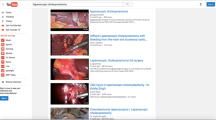Abstract
Background
Videos are used by surgeons when learning new techniques; however, online videos are often not vetted. Our aim is to review online videos of laparoscopic inguinal hernia repairs based on a benchmark for critical view of the myopectineal orifice (MPO) and safe inguinal hernia repair as defined by Daes and Felix and commonly referred to as “the 9 Commandments.”
Methods and materials
YouTubeⓇ was queried for “laparoscopic inguinal hernia repair.” The top 50 videos were ranked based on number of views. Those endorsed and/or vetted by surgical societies were excluded (n = 4). Three expert hernia surgeons scored the videos based on adherence to the 9 Commandments.
Results
The 50 videos originated from 11 countries. They had 72,825 mean views and a mean runtime of 14 min. Videos obeyed a median of 77.8% of commandments shown. Eight videos (16%) obeyed all 9 (100%) commandments. Three videos (6%) failed to obey any commandments. Operations employed TEP (18, 36%), TAPP (28, 56%), and rTAPP (4, 8%) approach. Stratification by approach showed significant variance in commandments obeyed (Kurskal–Wallis, p = 0.016) with significant difference between TEP and rTAPP scores (p = 0.008) and no significant difference between TEP and TAPP or rTAPP and TAPP scores.
Twenty-three videos (46%) displayed unsafe techniques including: threatened critical structures (16, 32%), rough tissue handling (15, 30%), and dangerous placement of fixation (9, 18%).
Conclusion
Online surgical videos on YouTube are not reliable in demonstrating best practices for minimally invasive inguinal hernia repairs. In our study, only 16% of the most viewed videos followed all 9 Commandments for critical view of the MPO. Many showed suboptimal repairs with significant safety concerns. While a significant number of online videos are a free and readily available resource for surgeons around the world, we recommend caution in relying on non-vetted videos as a form of surgical education.


Similar content being viewed by others
References
Pugh CM, Watson A, Bell RH et al (2009) Surgical education in the internet Era1. J Surg Res 156(2):177–182. https://doi.org/10.1016/j.jss.2009.03.021
McGee JB, Begg M (2008) What medical educators need to know about “Web 2.0”. Med Teach. 30(2):164–169. https://doi.org/10.1080/01421590701881673
Learn from the world’s best doctors, online | GIBLIB. https://www.giblib.com/. Accessed 7 May 2020
WebSurg, the online university of IRCAD. https://websurg.com/en/. Accessed 17 May 2020
SAGES TV: Laparoscopy and Endoscopy Surgery Videos. https://www.sages.org/video/. Accessed 7 May 2020
Press - YouTube. https://www.youtube.com/about/press/. Accessed 7 May 2020
Rapp AK, Healy MG, Charlton ME, Keith JN, Rosenbaum ME, Kapadia MR (2016) YouTube is the most frequently used educational video source for surgical preparation. J Surg Educ 73(6):1072–1076. https://doi.org/10.1016/j.jsurg.2016.04.024
Frongia G, Mehrabi A, Fonouni H, Rennert H, Golriz M, Günther P (2016) YouTube as a potential training resource for laparoscopic fundoplication. J Surg Educ 73(6):1066–1071. https://doi.org/10.1016/j.jsurg.2016.04.025
Topps D, Helmer J, Ellaway R (2013) YouTube as a platform for publishing clinical skills training videos. Acad Med 88(2):192–197. https://doi.org/10.1097/ACM.0b013e31827c5352
Sanford DE, Strasberg SM (2014) A simple effective method for generation of a permanent record of the critical view of safety during laparoscopic cholecystectomy by intraoperative “Doublet” photography. J Am Coll Surg 218(2):170–178. https://doi.org/10.1016/j.jamcollsurg.2013.11.003
YouTube. https://www.youtube.com/. Accessed 20 June 2020
The HerniaSurge Group (2018) International guidelines for groin hernia management. Hernia 22(1):1–165. https://doi.org/10.1007/s10029-017-1668-x
Reitano E, Cavalli M, de’Angelis N, Loriau J, Campanelli G (2020) Educational value of surgical videos on transabdominal pre-peritoneal hernia repair (TAPP) on YouTube. Hernia J Hernias Abdom Wall Surg. https://doi.org/10.1007/s10029-020-02171-0
Kurashima Y, Feldman LS, Al-Sabah S, Kaneva PA, Fried GM, Vassiliou MC (2011) A tool for training and evaluation of laparoscopic inguinal hernia repair: the Global Operative Assessment of Laparoscopic Skills-Groin Hernia (GOALS-GH). Am J Surg 201(1):54–61. https://doi.org/10.1016/j.amjsurg.2010.09.006
Daes J, Felix E (2017) Critical view of the myopectineal orifice. Ann Surg 266(1):e1–e2. https://doi.org/10.1097/SLA.0000000000002104
Tam V, Rogers DE, Al-Abbas A et al (2019) Robotic inguinal hernia repair: a large health system’s experience with the first 300 cases and review of the literature. J Surg Res 235:98–104. https://doi.org/10.1016/j.jss.2018.09.070
Bansal VK, Krishna A, Misra MC, Kumar S (2016) Learning Curve In Laparoscopic Inguinal Hernia Repair: experience at a Tertiary Care Centre. Indian J Surg 78(3):197–202. https://doi.org/10.1007/s12262-015-1341-5
Zendejas B, Peyre SE, Smink D et al (2011) Cognitive task analysis of the laparoscopic totally extraperitoneal (TEP) inguinal hernia repair: efficiency, slow-down moments and teaching principles. J Am Coll Surg 213(3, Supplement):S127. https://doi.org/10.1016/j.jamcollsurg.2011.06.304
Funding
This study received no external funding.
Author information
Authors and Affiliations
Corresponding author
Ethics declarations
Disclosures
Desmond Huynh, Negin Fadaee, Hakan Gök, Andrew Wright, Shirin Towfigh have no conflicts of interest or financial ties to disclose.
Additional information
Publisher's Note
Springer Nature remains neutral with regard to jurisdictional claims in published maps and institutional affiliations.
Rights and permissions
About this article
Cite this article
Huynh, D., Fadaee, N., Gök, H. et al. Thou shalt not trust online videos for inguinal hernia repair techniques. Surg Endosc 35, 5724–5728 (2021). https://doi.org/10.1007/s00464-020-08035-z
Received:
Accepted:
Published:
Issue Date:
DOI: https://doi.org/10.1007/s00464-020-08035-z




